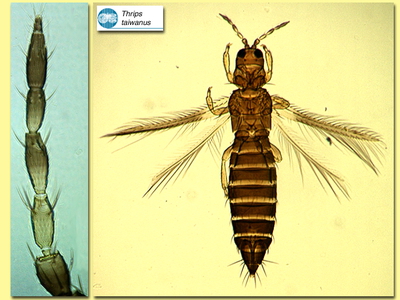Figures
Fig. 1 Antenna and head (dorsal)
Fig. 2 Head (dorsal)
Fig. 3 Pronotum
Fig. 4 Meso- and metanotum
Fig. 5 Fore and hind wing
Fig. 6 Sternite V and VI
Fig. 7 Tergite VII and VIII (female)
Species
Thrips taiwanus Takahashi
Biology
Apparently breeding in a range of flowers, but no published studies are available.
Distribution
From Thailand to the Philippines and northern Australia.
Recognition
Medium sized brown thrips, forewing dark with base pale; antennal segment III yellow, also base of IV & V. Antennae 7-segmented, sense cone on III & IV forked. Head with no setae in front of fore ocellus, one pair just outside anterior margins of ocellar triangle. Pronotum with 2 pairs of posteroangular setae. Metanotum with transverse lines of sculpture at anterior but polygonal reticulation on posterior half; median setae not at anterior margin. Forewing first and second veins with complete setal rows. Tergite II with 3 lateral marginal setae; V-VIII with ctenidia laterally, on VIII posteromesad of spiracle; posteromarginal comb on tergite VIII not developed. Sternites III-VI with a median row of up to 10 discal setae; sternite VII and all pleurotergites without discal setae.
Related species
Together with T. parvispinus andT. compressicornis, this is part of a complex of poorly defined species from south east Asia that requires further study. Currently they are distinguished from each other on character states most of which overlap, suggesting that only one variable species may be involved. However, antennal segment III of T. taiwanus is yellow, whereas this segment is largely brown in T. parvispinus.








